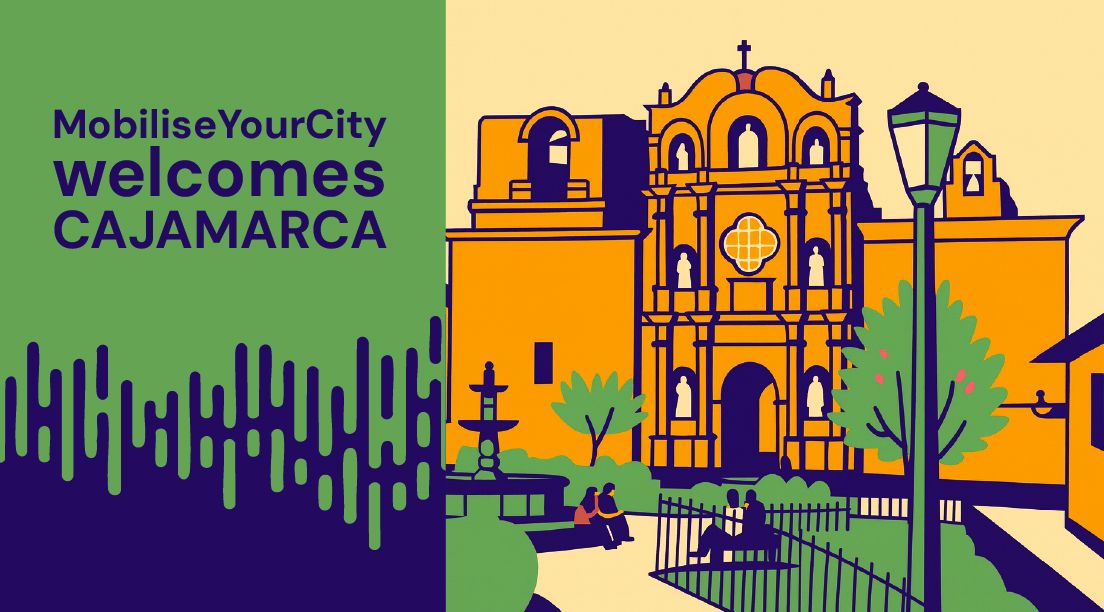MobiliseYourCity Welcomes Cajamarca: Advancing Safe and Inclusive Mobility in the Peruvian Andes

Perched 2,750 meters above sea level in a rugged inter-Andean valley in northern Peru, Cajamarca is home to over 348,000 residents. The city’s steep geography, narrow streets, and expanding urban footprint create a mobility landscape where public transport is essential. Yet much of this system operates informally, particularly in the mototaxi sector where only about a third of vehicles are registered. Congestion, safety risks, and limited accessibility for pedestrians and cyclists are persistent challenges, compounded by aging fleets and gaps in urban planning. With recent investments in road improvements and a clear commitment to change, the city sees its MobiliseYourCity membership as an opportunity to formalise services, improve safety, reduce emissions, and draw on international expertise and funding to create a more sustainable and inclusive transport system.
Public transport is central to everyday mobility in Cajamarca, with an estimated 80% of residents relying on combis, mototaxis, taxis, bicycles, and small cargo vehicles. However, only about one-third of mototaxis are formally registered, leaving the majority circulating without proper authorisation. This widespread informality undermines service quality and is closely linked to the city’s high number of traffic accidents, many occurring in known “black spots” where road conditions are poor. Weak land use regulation further limits the integration of transport networks with urban growth, making it harder for people to reach jobs, schools, and markets, especially by walking or cycling. Aging vehicle fleets contribute to local air pollution, while a lack of safe, regulated parking continues to strain the transport system.
In recent years, Cajamarca has taken steps toward improvement. In 2024 alone, the municipality invested more than 350 million soles in upgrading roads across all 24 sectors of the city. These works have included improving interurban connections such as the route to Chamis, creating new mobility services in neighbourhoods like Villa Huacariz, Mollepampa, La Paccha, and San Martín, and enhancing key corridors like Prolongación Av. Perú. Studies are also underway for public transport reorganisation and parking reform, laying the groundwork for longer-term change.
Through MobiliseYourCity, Cajamarca hopes to achieve a transformative shift in its mobility system. The city aims to build capacity to combat informality, address unsafe driving attitudes, and reduce the high rates of road accidents with serious injuries and fatalities. Plans include implementing key planning instruments such as a Sustainable Urban Mobility Plan (PMUS) and a Route Regulatory Plan (PRR), as well as promoting cleaner, more efficient vehicles powered by alternative fuels to cut carbon emissions and improve air quality. Another priority is developing processes to secure funding from international cooperation and direct these resources into transport infrastructure projects.
By combining recent local investment with the technical expertise, peer exchange, and global visibility of the MobiliseYourCity network, Cajamarca has the potential to create a transport system that is safer, more inclusive, and better adapted to its unique Andean context.An estimated 80% of residents depend on combis, mototaxis, taxis, bicycles, and small cargo vehicles to move around the city. Yet, while public transport is the backbone of daily life, much of it operates outside formal regulation. Nine thousand three hundred seventy-seven mototaxis are formally registered—about 35% of the total fleet—meaning nearly 27,000 units are in circulation, with around 17,600 running informally.
Cajamarca faces a mix of infrastructural, regulatory, and environmental mobility challenges. Congestion is common in central corridors, while a significant proportion of passenger transport services operate informally, often without the required permits or licenses. This contributes to a high incidence of traffic accidents, especially in known high-risk “black spots” where poor road conditions add to safety concerns. Weak land use regulation limits the integration of transport networks with urban growth, reducing accessibility for pedestrians and cyclists to essential destinations like schools and markets. In addition, aging vehicle fleets generate local air pollution, and the lack of safe, regulated parking further strains the transport system. Despite these issues, Cajamarca has taken steps toward improvement. In 2024, more than 350 million soles were invested in upgrading roads across all 24 city sectors. Projects have focused on enhancing interurban connections, creating new local mobility services in underserved neighbourhoods, and improving transit flow in key corridors. Studies are also underway for public transport reorganisation and parking reform.
By joining the MobiliseYourCity Partnership, Cajamarca is positioning itself to transition from piecemeal improvements to a comprehensive, strategic mobility plan. Membership offers opportunities to develop a Sustainable Urban Mobility Plan (SUMP) and a Route Regulatory Plan (PRR), both crucial for formalising and modernising public transport. Access to international expertise and best practices can support efforts to reduce transport informality, improve safety, and promote cleaner, more efficient vehicle fleets. Collaboration with other MYC members can also help Cajamarca address cross-cutting issues, such as integrating land use and transport planning, expanding active mobility infrastructure, and designing climate-resilient transport systems for a city with distinct wet and dry seasons. With targeted support and shared knowledge from the network, Cajamarca has the potential to transform its transport system into one that is safe, inclusive, and environmentally sustainable.